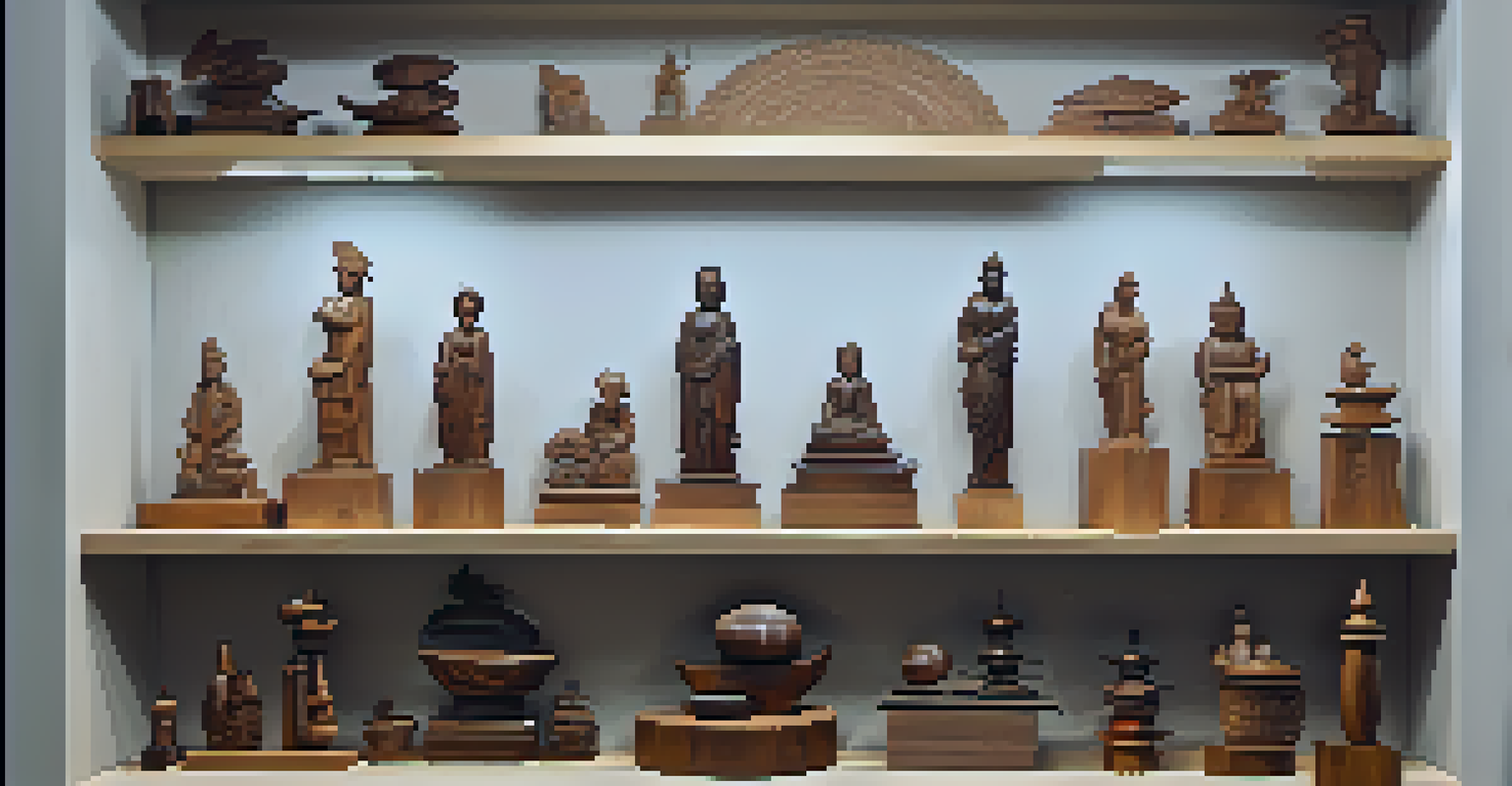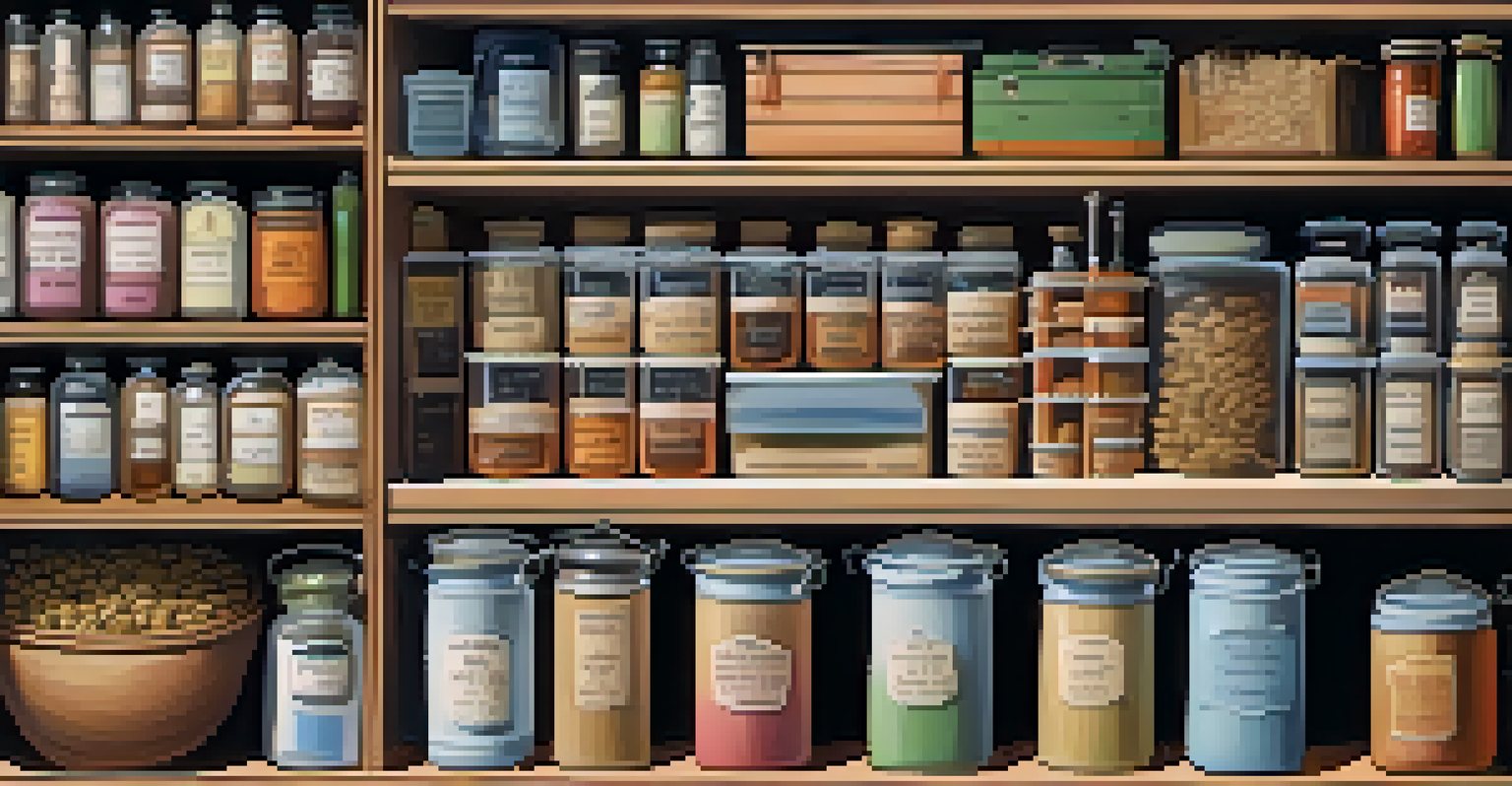Creating a Safe Storage Environment for Carved Artworks

Understanding the Importance of Proper Storage
Storing carved artworks correctly is crucial for their preservation and longevity. These pieces, often made from delicate materials, can easily be damaged by environmental factors. Proper storage not only protects the artwork but also maintains its aesthetic and monetary value over time.
Preservation of art is not just about keeping it safe; it’s about honoring the creativity and effort that went into its creation.
Imagine a beautiful wooden sculpture left in a damp basement. Over time, moisture can warp the wood, causing cracks and fading colors. By understanding the importance of proper storage, you can prevent such scenarios and keep your carved treasures safe.
Ultimately, a thoughtful approach to storage can mean the difference between a treasured heirloom and a ruined piece. Let’s dive into the steps you can take to create a safe storage environment for your carved artworks.
Choosing the Right Storage Location
The location where you store your carved artworks plays a significant role in their preservation. Ideally, you want a climate-controlled environment that is free from extreme temperatures and humidity fluctuations. Basements and attics, while often used, can be problematic due to their tendency to trap moisture or heat.

Consider using a room with stable temperature and low humidity, such as a dedicated storage closet. This can help ensure that your artworks are safeguarded against mold growth and wood warping. It’s much like choosing a comfortable spot for a plant; the right environment encourages healthy growth.
Proper Storage Ensures Longevity
Storing carved artworks correctly is vital for their preservation and maintains their aesthetic and monetary value over time.
By selecting the right location, you lay the foundation for the longevity of your carved artworks. Let’s explore the next steps to keep those pieces safe and sound.
Utilizing Appropriate Storage Materials
When it comes to storing carved artworks, the materials you use can make a big difference. Opt for acid-free boxes or containers that won’t emit harmful chemicals. These materials are designed to protect delicate surfaces from dust, dirt, and potential damage.
Art is a reflection of our culture, and preserving it ensures that future generations can appreciate its beauty and significance.
Think of it as wrapping your favorite fragile items in bubble wrap. Just as bubble wrap provides cushioning, acid-free materials offer a protective barrier. This helps in maintaining the integrity of the artwork while also preventing scratches or other wear and tear.
Investing in the right storage materials can save you from costly repairs or replacements down the line. Now, let's look at how to arrange your carved artworks for optimal protection.
Properly Arranging Your Carved Artworks
How you arrange your carved artworks in storage can significantly impact their safety. Avoid stacking items on top of one another, as this can lead to crushing or scratching. Instead, keep each piece separated and secure within its own protective container.
Picture a crowded bookshelf where books are crammed in tightly; inevitably, some will get damaged. Similarly, allowing enough space between your carved artworks ensures that they can breathe and remain unharmed. Consider using dividers to create dedicated sections for each piece.
Monitor Environment Regularly
Keeping an eye on temperature and humidity levels is crucial to prevent damage to your carved artworks.
By thoughtfully arranging your artworks, you enhance their protection and make it easier to access them when needed. Let’s discuss the importance of monitoring environmental conditions.
Monitoring Temperature and Humidity Levels
Maintaining the right temperature and humidity levels is vital for the preservation of carved artworks. Ideally, you want to keep the temperature between 65°F and 75°F, with humidity levels around 40%-50%. Fluctuations can lead to significant damage over time.
Using a thermometer and hygrometer can help you keep an eye on these conditions. Think of it like checking the weather before heading out; knowing the forecast helps you plan accordingly. Regular checks can prevent unforeseen damage from sudden changes in the environment.
By monitoring these factors, you can create a stable environment that supports the longevity of your carved artworks. Next, we’ll touch on the importance of regular inspections.
Conducting Regular Inspections of Artworks
It’s essential to conduct regular inspections of your carved artworks to catch any signs of damage early. Look for cracks, fading, or any signs of pests. Catching these issues early can make a significant difference in the preservation process.
Think of it like regular check-ups at the doctor; early detection can lead to better outcomes. By making inspections a routine part of your artwork care, you can ensure that any potential problems are addressed promptly.
Regular Inspections Catch Issues
Conducting routine inspections of your carved artworks helps detect and address potential damage before it worsens.
Incorporating this practice into your storage routine helps maintain the beauty and integrity of your carved artworks. Now, let’s explore the significance of keeping artworks clean.
Keeping Your Carved Artworks Clean
Cleaning your carved artworks is an essential part of their care and maintenance. Dust and dirt can accumulate over time, leading to dullness or even damage to the surface. Use a soft, dry cloth to gently wipe down your pieces, avoiding any harsh chemicals that could cause harm.
It’s akin to giving your artwork a little spa treatment; a gentle clean can rejuvenate its appearance. For intricate carvings, consider using a soft brush to reach those harder-to-clean spots. Regular cleaning not only improves appearance but also protects the artwork from potential damage.

By prioritizing cleanliness, you contribute to the overall longevity of your carved artworks. Finally, let’s wrap things up with some final thoughts on preserving your treasures.
Final Thoughts on Artwork Preservation
Creating a safe storage environment for carved artworks is a rewarding endeavor that pays off in the long run. By understanding the importance of proper storage, choosing the right location, utilizing appropriate materials, and conducting regular inspections, you can ensure your artworks remain beautiful for years to come.
Think of your carved artworks as cherished family members; they deserve the best care possible. With a little effort and attention, you can create a sanctuary for these pieces that honors their beauty and craftsmanship.
In the end, preserving your carved artworks is about more than just storage; it’s about valuing the artistry and memories they hold. So, take these steps to create a safe haven for your treasured pieces.